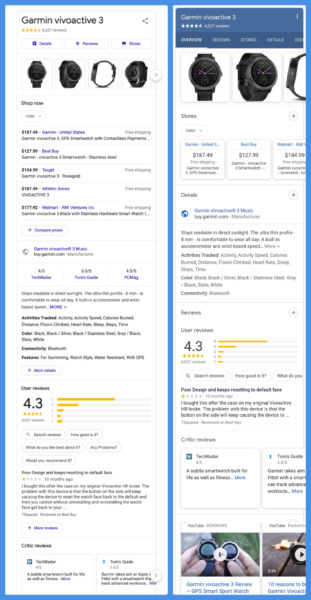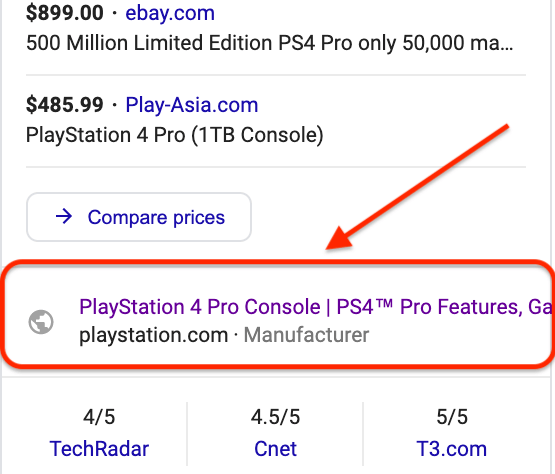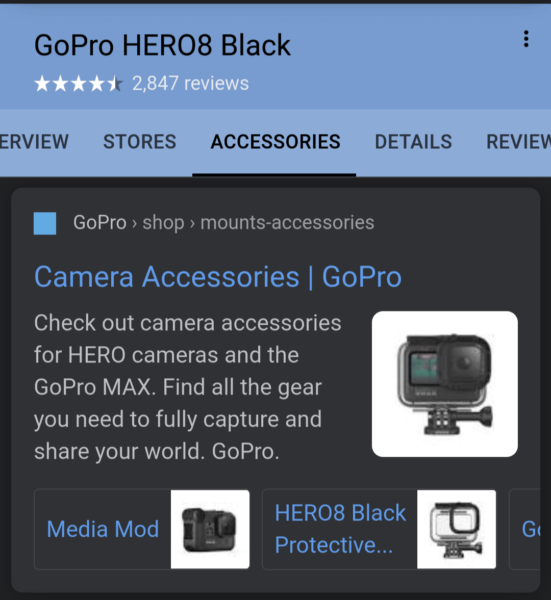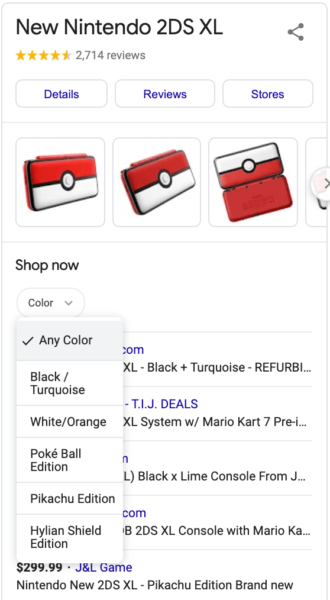How to get the most out of Google’s product Knowledge Panels
What manufacturers and retailers need to know to take advantage of product Knowledge Panels in search.
Product Knowledge Panels may be the first place shoppers encounter information about a product they’re interested in — and, they may never need to leave the Knowledge Panel to conduct their research, read reviews or compare prices. This makes the product panel the frontline in terms of providing potential customers with the information they need to decide whether they’re going to buy, and possibly who they’re going to buy from.
Within the product panel, brands and manufacturers can make pertinent information easily accessible to shoppers, and retailers have the opportunity to attract those shoppers to their product detail pages. This guide will provide manufacturers, retailers and the agencies that work with them with an overview of ways that they can help build out their product panels to inform potential customers and increase the odds of making the sale.
What are product Knowledge Panels?
Knowledge Panels organize and display information about entities within the Knowledge Graph. They typically appear on the right-hand side of Google and Bing desktop search results, and towards the top of the results on mobile.

Product Knowledge Panels are the variation of Knowledge Panels designed specifically for products. They differ from brand Knowledge Panels and local Knowledge Panels in that they cannot be claimed by a business, and the features that appear in the panel are aimed at helping users navigate the pre-purchase stages of their customer journey, such as reading reviews and comparing prices.
The SEO benefits of product Knowledge Panels
“In general, a product Knowledge Panel makes information a lot easier to be found by searchers, and we can assume this might eventually turn into more sales,” said Andrea Volpini, CEO of WordLift. Product descriptions, attributes, photos and reviews are common components of product Knowledge Panels (KPs) and can help potential customers decide whether they want to buy a given product.
Many product KPs contain prices and links to product description pages from various sellers, enabling users to compare prices at a glance and head to a retailer’s site to complete their purchase. “Product Knowledge Panels are a one-stop shop inside Google search,” he said, adding that retailers “most probably want to be there because it’s another window that you can use for exposing your offer.”
“For the manufacturer, I would say the biggest benefit is it’s free and it’s big, especially on a mobile device — it completely dominates the search results page there, it really draws consumers in,” said Evan Kirkpatrick, VP, shopping and feed management at Tinuiti.
The information within product KPs comes from merchants, manufacturers and structured data on web pages. Google may also include content from the open web if it has been crawled and is related to retail.
Although product KPs can’t be claimed, you can help ensure the information within your products’ panels are accurate by using the following platforms and techniques.
Google Manufacturer Center. Launched in 2015, this platform allows manufacturers, brand owners and brand licensors to submit product information, such as product titles, descriptions, images, key features and related YouTube videos, to Google. The information may then be used to improve descriptions and provide relevant information within Google search.
Manufacturer Center can fill in data gaps and help ensure retailer listings trigger to show a manufacturer’s products. Additionally, Manufacturer Center provides impressions, clicks and other performance metrics for products.
Google Merchant Center. The retailer counterpart to Manufacturer Center, Merchant Center allows sellers to provide Google with details that may promote the sale of a given product and may contain information specific to that retailer, such as sale price, availability, shipping information and so on.
It’s possible for manufacturers to use both Manufacturer Center and Merchant Center. For manufacturers that sell their own products, maintaining consistent information on both platforms can help Google reconcile product details. Note that Merchant Center feeds are compatible with Manufacturer Center as long as the required fields (gtin, id, brand, title, description, and image_link) are included in the feed.
Structured data. Information about a product, such as brand, ratings, GTIN (global trade item number), physical dimensions, description and so on, can be provided to search engines through structured data markup. Search engines can then use this information to populate search features, such as product Knowledge Panels or Google’s mobile Popular Products carousel.
Search engines may also use structured data to establish connections within the Knowledge Graph. For example, the SameAs property can indicate a product’s identity so search engines know that the item you’re selling is the same one listed on its manufacturer’s website. The more information there is in the Knowledge Graph about a given product, the more comprehensive its Knowledge Panel is likely to be, enabling search engines to show ratings, reviews and other details.
Wikipedia and Wikidata. As is the case with brand KPs, Wikipedia can be a data source, and Wikipedia articles are sometimes cited in the description section of product panels.

While having a Wikipedia page does increase your chances of earning a product KP and populating it with relevant information, it is not necessary and may not be appropriate for all products, such as whitelabeled products that are sold under various brand names.
Wikidata, the repository of structured data used by Wikimedia projects (such as Wikipedia) that replaced Freebase when it shut down in 2015, can also be used to provide the Knowledge Graph with more information about your products.
You can learn more about how to use Wikipedia and Wikidata for your Knowledge Panels in our brand Knowledge Panel guide. However, you should first focus on managing your products in Google Manufacturer Center and Merchant Center, as those platforms seem to have more direct influence over product KPs.
How manufacturers and retailers can influence the product Knowledge Panel
Data quality and accuracy is key to capitalizing on product Knowledge panels.
For brands and manufacturers. “If you can do only one thing, I would probably start with the Manufacturer Center [if you’re a manufacturer] or Merchant Center [if you’re a retailer],” Volpini said. This is because Google wants the authoritative product information that manufacturers are able to provide.
As mentioned previously, manufacturers can submit titles, descriptions, images and YouTube videos pertaining to their products directly to Google through Manufacturer Center. “You can have more control over what appears in the product Knowledge Panel: You can add new products, delete products, update what you have in there and monitor the quality of what’s coming through [and] any errors you’re seeing,” Kirkpatrick said, pointing to product images as one example. “Retailers might not have the highest quality images; as a manufacturer, you’re going to have the originals, so it’s easy for you to go in and add the pictures you want to show users,” he said.
Google also gives preference to Manufacturer Center feeds over Merchant Center feeds, meaning that providing your own product information through Manufacturer Center may help you correct inaccuracies from other sources.
The product KP can also provide a link to the manufacturer’s product detail page, where you can show users reviews, provide them with more information as well as links to retailers that sell the product. Manufacturer Center feeds contain a product page URL column where the appropriate page can be designated; however, adding a URL here does not guarantee that it will display in the panel.

“In the Knowledge Graph, information needs to be corroborated by multiple sources, so we don’t expect that if you [add the URL in Manufacturer Center], you will get the link, but it’s most likely that it will happen,” Volpini said, noting that, in general, it may be easier for manufacturers to influence less established Knowledge Graph entities, such as niche products, as opposed to popular products in which there may already be a large amount of data present.
Your product detail pages can also help corroborate and expand upon the information in your Manufacturer Center feeds through structured data markup.
“Using structured data is like painting your own version of the product with a broader palette of colors, because you can kind of combine different elements,” said Volpini, adding that “If you have reviews, you want to mark them up with the same identifiers; if you have a video inside an article, you want to reference the video to the same product identifier, and so forth — you get to build the information around the product in the open web using structured data.”
When used in tandem, product identifiers, such as GTIN, and certain structured data properties can enable Google to add more elements to the product KP. “The interaction can change if I add information about accessories,” Volpini said, suggesting that using the isAccessoryOrSparePartFor property can help Google establish a link between related products.

“The [product KP] interface is dynamic and it’s driven by the data, so if the data is consistent and accurate, then I improve the chances of being seen and the engagement that the end user can have with my product,” he said.
Supplying your retailers with accurate product information can also help to ensure consistent data across the web. If Google sees that the specs on a given product are the same from site to site, the information within product KPs is more likely to be accurate and useful for potential customers.
For retailers. Product KPs provide merchants with an opportunity to reach potential customers through the free product listings that often appear within them. “It’s all through the unpaid [channel] once you go into the Knowledge Panel,” said Kirkpatrick, noting that queries that trigger product KPs are often high-quality search terms that advertisers can’t run paid shopping ads through, making organic listings even more valuable.
Retailers looking to get their Shopping listings to show in product KPs must do so through Merchant Center by uploading a product feed and then opting into Surfaces across Google. This also has the added benefit of enabling your products to appear in Google search, Shopping and Image results, for free, as well.
“The most important thing for these retailers is to have GTINs embedded within your product feed and within Merchant Center, because these Knowledge Panels are for one specific product, all tied together through this GTIN — if you’re not providing that same GTIN, you’re not getting in that Knowledge Panel,” Kirkpatrick said, adding that competitive pricing should also be a consideration. “If your price is three times as much as your competitors, your chances of showing up there are not as high,” he said.
Designating variations in a given product, such as color or material, can also help users find what they’re looking for.

In the example above, selecting a color changes the organic Shopping listings users are presented with. Omitting this data may result in your listings not showing up when users filter for a product variant.
Implementing structured data on your product detail pages (for your reviews, for example) may help Google build out the Knowledge Panel for that particular product, but the benefit of that will be spread across users, the manufacturer and other retailers as well.
It’s all about the data
“Data quality is the new optimization strategy,” Volpini said, adding, “We tend to underestimate the importance of data quality, but in the context of e-commerce, it becomes essential.” Product Knowledge Panels show that search engines like Google seek to become a destination for users to make purchasing decisions.
Since users may encounter product information through search features before they ever even click on a landing page, manufacturers and retailers must seek out every opportunity to influence the search results. Using the platforms and techniques that make it easy for Google to surface that information for potential customers can help you reach them early on.
Contributing authors are invited to create content for Search Engine Land and are chosen for their expertise and contribution to the search community. Our contributors work under the oversight of the editorial staff and contributions are checked for quality and relevance to our readers. Search Engine Land is owned by Semrush. Contributor was not asked to make any direct or indirect mentions of Semrush. The opinions they express are their own.


